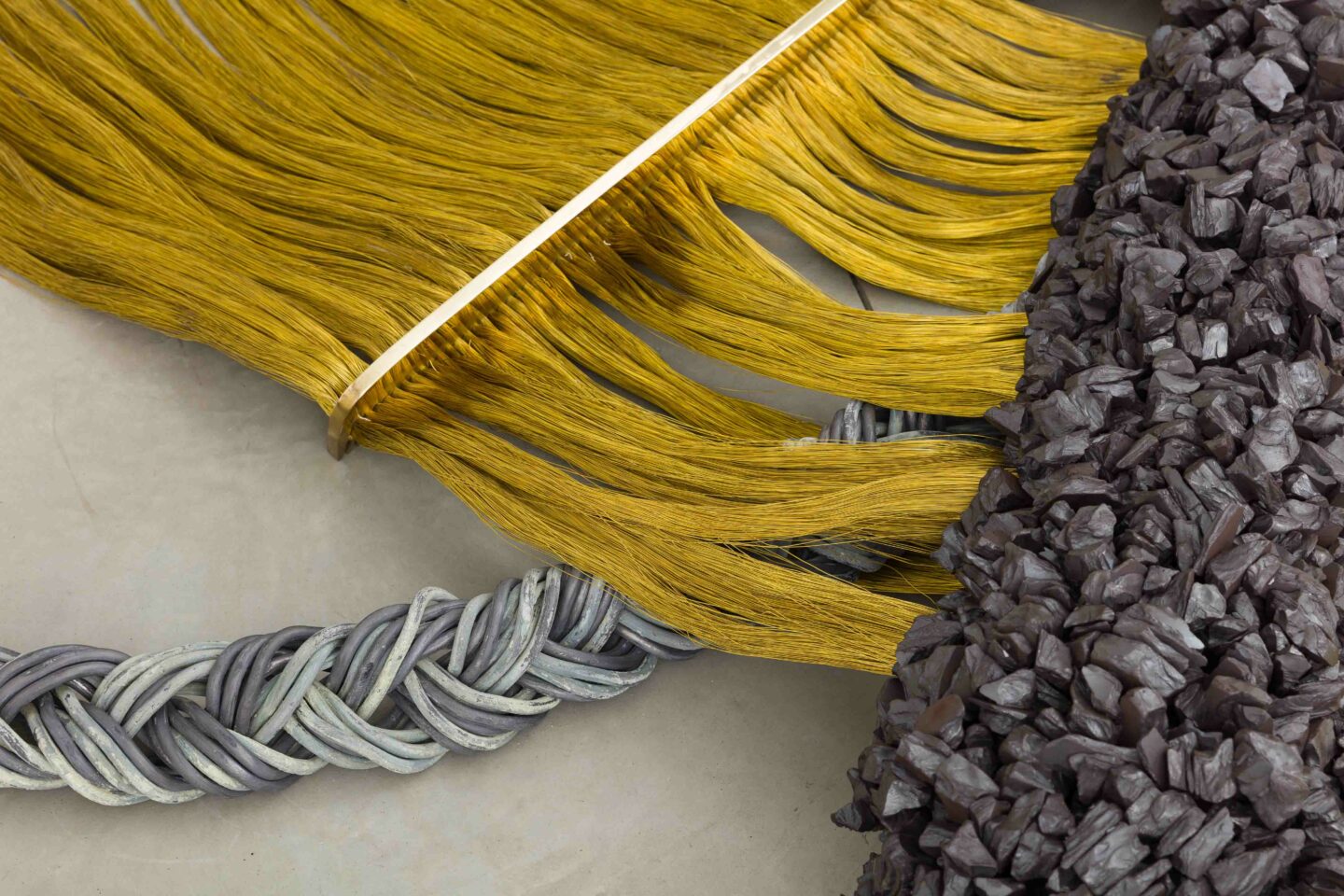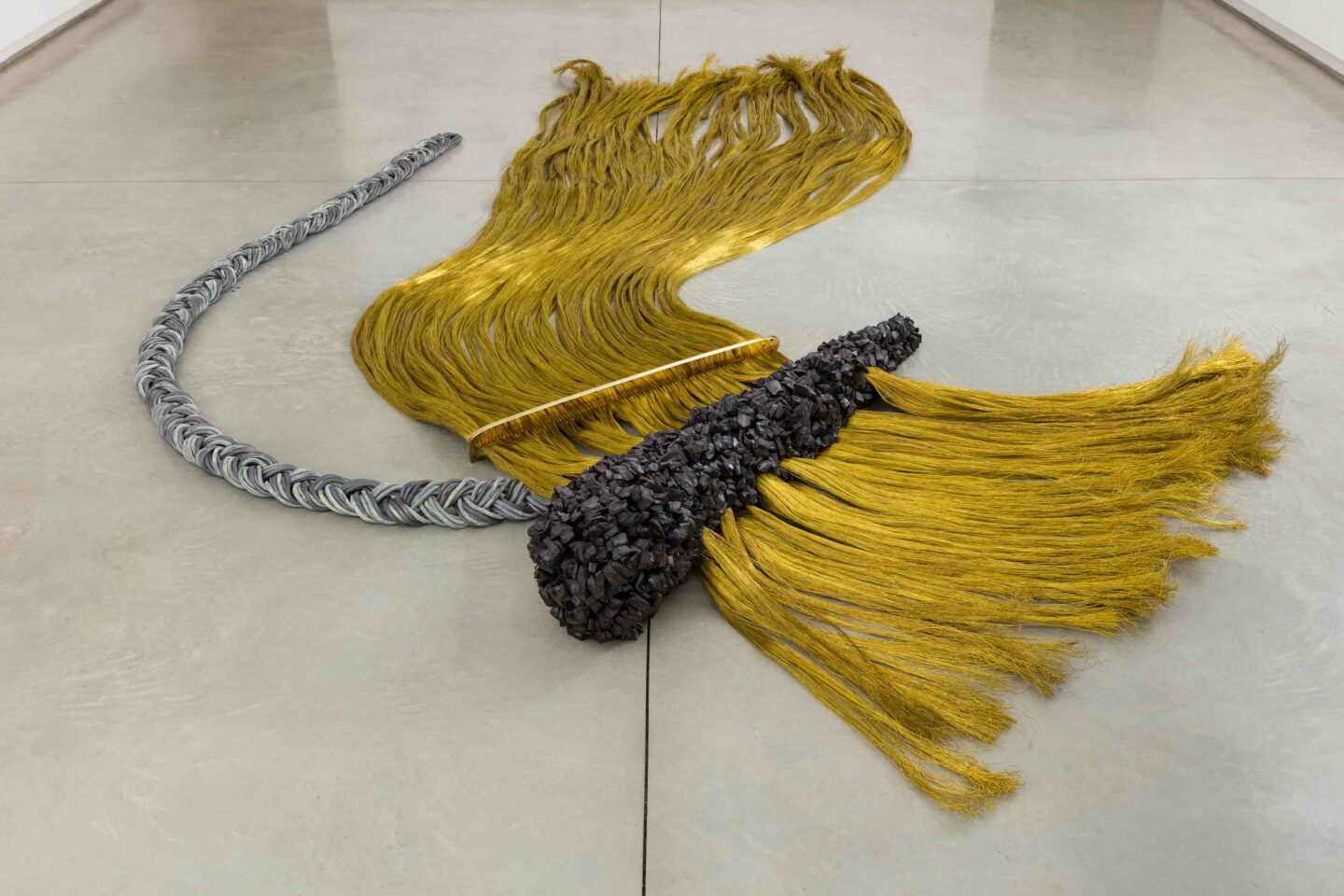Three simultaneous exhibitions synthesize the universe of one of the vectors of contemporary Brazilian art, offering a panorama of Tunga’s work. This triad of exhibitions exemplifies the extensive repertoire of an artist recognized internationally for the boldness of the pieces exhibited here: Êxtases, on show at Millan, is a “symphonic” work, in the artist’s own terminology, as it ties together a series of works in just one; Eu, Você a Lua, which opens on the 8th of August at Museu de Arte Moderna (MAM/SP) and finally, Tríade Trindade, which greets visitors to the Pina Contemporânea.
On show since the opening of the new museum at Luz in São Paulo, Tríade Trindade (2001) brings together perennial forms in Tunga’s work, such as the bell cast in iron, the long weave of threads of metal that pour out from a cauldron installed under the bell, and a TaCaPe impregnated with fragmented magnets. The cauldron is suspended from a tripod of walking sticks that evoke the structure of a support for rifles.
As always, there are references in this piece to older works by Tunga, among them Barrocos de Lírios (1994), transfigured into blankets of braided recycled fibers, as well as Cooking Crystals (2008–2010), which takes the form of bottles, chalices and funnels being “heated” in an immense cauldron. The piece was originally installed at Jeu de Paume, Paris, in 2001, and subsequently at other locations (New York, Frankfurt) until it became part of the collection at the Pinacoteca do Estado, in 2018.

Ecstasy – photo: Ana Pigosso
The role of the magnetic fields in Tríade Trindade is the same as in other works by Tunga which make use of similar materials: the search for a new type of relationship among beings, a type of specular mimicry in which one can, at least momentarily, be other, experience otherness.
This is the case, for example, of the twins conjoined by their hair (Xifópagas Capilares entre Nós, 1984), a fable created by Tunga partly inspired by his own family history (his mother is one of the twin sisters portrayed by Guignard, in The Twins, from 1940).
This identification among beings stayed with Tunga from the moment he read Goethe’s novel Elective Affinities, in which everything comes in pairs, from the male to the female protagonists, like an alchemical process. Goethe observes the likeness by way of one of the characters in his classic novel.
Tunga produced a work with the same title, which proved fundamental to understanding other autobiographical works that approached the theme of 'mutual contagion,' to which the artist alluded when defining the countless 'descendants' of Elective Affinities.
In a certain sense Me, You and the Moon (2015), is an exemplary case of the ascendancy of Trinity Triad and Elective Affinities (2001–2004). This group of works which now takes the place occupied by Louise Bourgeois’ Spider (1996) at the Museu de Arte Moderna de São Paulo (MAM/SP), seduces the spectator with parabolic mirrors, the essence of amber, and quartz crystals which previously enchanted visitors to the castle of Chaumont-sur-Loire, France, in 2015.
From the tip of a phallic and Pantagruelian finger, this amber essence drips onto a plate. Images of bottles are reflected in the work’s mirrors, while replicas of fingers in bronze point simultaneously to the sky and earth in an allegorical representation that brings to mind the divine hand that emerges from the sea in Landscape in the Mist by Greek director Theo Angelopoulos. In the film, the finger disorients ordinary mortals in a telemachy that metaphorically references the search for the Father. It is no different in Tunga's work.

Ecstasy – photo: Ana Pigosso
Finally, in Ecstasy (1987), on show at Millan, a sculpture cast in tin, lead and magnets that hold down clumps of hair, the mystery does not come from the mirroring of pairs, but from the relationship between three elements, as is seen in the three columns of iron of the tripods of the piece Trinity Triad, a highly personal vision of the dogma of the trinity for Tunga.
The question raised by the Augustinian allegory of the boy who wants to put all the water in the ocean into a thimble is not tied to theology, but comes to Tunga via Wittgenstein, in other words, through the possibility of enunciating theological truths within a constituted language.
The question of arranging the Trinity as a Unity in a precise physical situation is a problem Tunga resolves by creating the illusion that three can be one. He had already performed the feat with three candles in an installation that formed a Unity while burning (Sero Te Amavi, 1992, similarly based on the challenge of the boy questioning Saint Augustine about the Holy Trinity).
In Ecstasy, a comb establishes order in chaos represented by threads of copper hair, braids of lead, and a “tacape” of magnets. On passing through the comb, the metallic strands are separated and attain individuation. The surface of the comb functions as a mirror reflecting what the strands had been as they pass from one side to the other.
The return to the specular question, in the room where the piece is installed at Millan, leads the spectator to the watercolors of the series Quase Auroras (2005), which deal with the transmutation of bodies, as in alchemy. Palm trees become feminine bodies and what was once a straight (and erect) line, simulating the male body, takes on a new configuration. In these three different locations, Pina Contemporânea, Museu de Arte Moderna, and Millan, Tunga proposes new readings of that naggingly enigmatic question: of how three can be one. A serious challenge.
São Paulo, Brazil
São Paulo, Brazil
Gwangju, South Korea
Rio de Janeiro, Brazil
Riberão Preto, Brazil
São Paulo, Brazil
Porto Alegre, Brazil
Arévalo, Spain
Porto Alegre, Brazil
São Paulo, Brazil